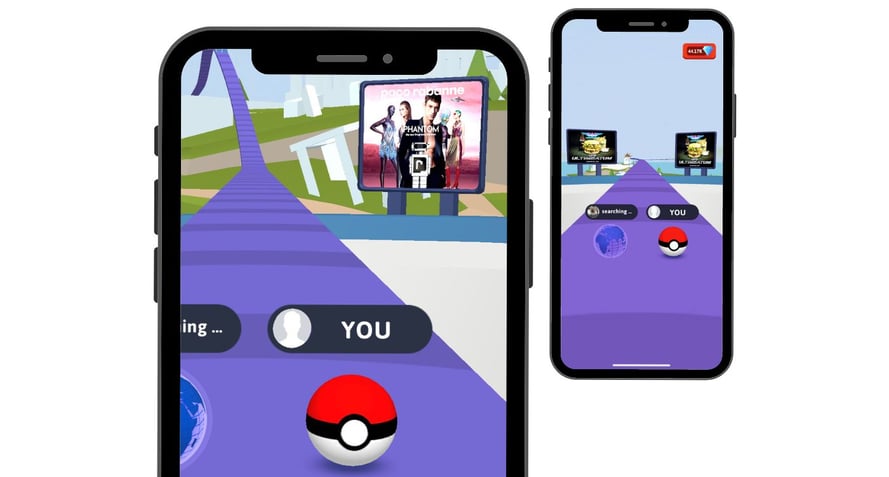- Newsroom
- >
- APPS' Viral Hits and Anzu's In-Game Advertising: A Perfect Match

APPS' Viral Hits and Anzu's In-Game Advertising: A Perfect Match
Anzu’s intrinsic in-game advertising solution has quickly become a hit with indie game developers, offering them a way to monetize their games without taking anything away from the player experience. In this blog series, we sit down with a number of indie studios that are using Anzu’s solution to understand what impact it has had.
We were delighted to speak with Orhun Mert Simsek, Co-Founder & CMO at APPS, the mobile game studio responsible for viral hits including Fashion Battle, Carpet Roller, and Trivia Race 3D. If you haven’t played their titles, it’s likely you’ve seen someone playing them either on the commute to work, on social media (Fashion Battle became an overnight sensation thanks to TikTok), or next to you on the sofa!
Why did you decide to implement in-game ads?
We aim to put players first, above everything we do, and to improve our games based on their feedback. We needed a way to fund our work. However, we didn’t want to compromise on the gameplay, nor did we want to charge players for playing our games.
After hearing about Anzu’s in-game advertising formats, bringing them on board was a no-brainer as they don’t interrupt the flow of our experiences, are not clickable, so they don’t take players away, and they add a sense of realism to our games by appearing on posters and banners which are placed alongside our tracks, much like they would in the real world.
A bonus is that we can also use them to cross-promote different games from our offering, especially when we launch a new title, or we implement a big update - this is a really cool way to communicate with our audience that feels natural and non-intrusive.
We initially tested Anzu’s in-game ads out in Trivia Race 3D. After seeing the fantastic results and hearing positive feedback from our players, we implemented them in another game called Carpet Roller, and when we were creating our latest title Fashion Battle, we were mindful that we wanted to use in-game ads to fund it and so we ensured we built the game with this in mind, building the placements in during the creation process.

How easy were the ads to integrate?
When a new SDK is added, it often causes collisions with others. Anzu was on hand to help with this and their fast response times and overall support were really helpful in getting us up and running as quickly as possible.
Anzu also advised us on what placements to add and, over time, helped us optimize them to ensure they were in the best possible positions to be viewed by our players, ensuring we were getting the most out of them. Their ongoing support is one of the main reasons we have continued working with them.
How have players responded to the ads?
We are regularly in touch with our community of gamers and haven’t had any negative feedback from them since we added the in-game ads, making me believe that they are a natural fit within our games.
To take this a step further, we ran several A/B tests to see how well in-game ads worked in comparison to interstitials. The exposed group of gamers played our games with in-game ads, and the control group with interstitials.
The experiment revealed that the control group saw lower retention rates while the exposed group was not affected, reinforcing the fact that Anzu’s in-game formats perfectly suit our games.
What impact have you seen from the ads?
Anzu has helped increase our in-game ads revenue by 131%, with them now making up between 5% and 10% of our total monthly revenue. Part of this growth comes from some countries where we did not initially see much engagement. However, after implementing Anzu's technology, revenues began soaring, and in-game ads now make up more than 50% of our monthly income in several different locations.
Anzu also helped us implement video ads for the first time, which have performed really well and had a big impact on our overall in-game ad revenue. It was really easy to start making additional revenue as soon as everything was implemented, as Anzu manage all the deals and optimization of the ads from their end.
-3.jpg?width=1400&height=752&name=Sims%202%20vs%20Sims%204%20fashion%20packs%20(2)-3.jpg)
Can you tell us a bit about the impact the transparency and consent framework has had?
The transparency and consent framework (TCF) 2.0 gives publishers greater control and flexibility for how they integrate and collaborate with their technology partners with the ability to restrict the purposes for which personal data is processed on a per-vendor basis.
This was something that the Anzu team recommended doing, and I’m glad we did, as it has allowed us to open our games up to even more brands and agencies across Europe. Our EU revenue before adding TCF 2.0 at the beginning of 2021 was between 1% to 5%. After implementing it now makes up 20% to 23%!
With Anzu’s help, we have also welcomed ads from advertisers across the globe, offering them global reach, with our top regions including the US, UK, France, Canada, and Australia.
Finally, what advice would you give to another studio thinking about in-game ads?
I would recommend in-game ads as, as I previously mentioned, they do not interrupt the experience or send users away. Also, if you are unsure where the ads will work best in your games, Anzu is excellent at providing recommendations and advice because the team has learned from years of experience.
We took their advice, to begin with, and have then been A/B testing different areas, times, and placements to see what works best. This optimization process is worth it as it has helped us figure out precisely what locations work best to ensure we optimize the placements for optimum revenue.
Find out more about how in-game ads have impacted APPS in this case study.

Nick is Anzu's Content Lead. As a gamer with a background in AdTech, he has a unique perspective on the industry and the in-game advertising sector.